Plants Ideal for Moisture-Rich Soil: Top Choices to Examine
In environments with consistently moist or poorly drained conditions, finding the right trees and shrubs can be a challenge. However, plants that thrive in wet soil are adaptable, with their moisture tolerance, light requirements, soil preferences, and hardiness zones all playing crucial roles. Here are some top choices for both trees and shrubs that are well-suited for wet soil environments.
### Trees for Wet Soil
Our list includes the Atlantic White Cedar, Loblolly Pine, Balsam Fir, Black Spruce, and River Birch. Each of these trees has unique characteristics that make them ideal for wet soil environments.
The Atlantic White Cedar, a native evergreen tree of the eastern United States, thrives in wet, swampy soil and prefers full sun to partial shade. It's an excellent choice for wetland restoration and can be found in hardiness zones 4-7. Known for its spire-like shape and reaching heights of 80 to 115 feet, the Atlantic White Cedar is also a larval host plant for butterflies and provides cover for wildlife.
Loblolly Pines are common in the wetlands of the southeastern U.S. and prefer moist to wet soils under full sun. They are well-suited for zones 6-9.
Balsam Fir prefers cooler climates with consistent moisture and can tolerate wetness. It thrives in full to partial sun and acidic, moist soils, making it a good choice for hardiness zones 3-6.
Black Spruce is native to bogs and wetlands in cooler climates and can withstand wet, acidic bogs. It prefers full sun to partial shade and acidic, wet soils, making it suitable for hardiness zones 2-6.
River Birch, known for its fast growth and attractive peeling bark, is flood-tolerant and thrives in humid, wet soils. It prefers full sun to partial shade and moist, well-drained to wet soils, making it a top choice for zones 4-9.
### Shrubs for Wet Soil
For shrubs, we recommend Canadian Wild Ginger, Blue Phlox, and Grassy-leaved Sweet Flag.
Canadian Wild Ginger is a shade-loving, ground-covering plant that thrives in rain-prone shaded spots and prefers moist, well-drained to wet soils. It's suitable for hardiness zones 4-6.
Blue Phlox adds spring color to wet soil environments and is adaptable to various soil textures. It prefers perpetually moist soil and tolerates wet soil, making it a good choice for hardiness zones 3-8.
Grassy-leaved Sweet Flag is ideal for streamside plantings, ponds, or water gardens. It thrives in waterlogged, wet soils and prefers partial to full sun. It is suitable for hardiness zones 6-9.
### Key Considerations
When selecting trees and shrubs for wet soil environments, it's essential to consider moisture and soil type, light requirements, hardiness, and visual and ecological benefits. Most wetland species do well in full sun to partial shade, but some understory shrubs prefer shade. Hardiness zones vary widely, with northern species like black spruce thriving in cold climates (Zones 2-6), while others like loblolly pine thrive in warmer wet areas (Zones 6-9).
Several wet-soil trees and shrubs also offer aesthetic value (e.g., river birch with its peeling bark, blue phlox for spring color) and ecological benefits such as supporting wildlife and preventing soil erosion. Atlantic White Cedars, in particular, are suitable for butterfly, pollinator, or rain gardens.
References: [1] The Spruce, 2021. The 10 Best Trees for Wet Soil. [Online]. Available at: https://www.thespruce.com/trees-for-wet-soil-1412235 [2] Gardening Know How, 2021. Trees for Wet Soil. [Online]. Available at: https://www.gardeningknowhow.com/garden-how-to/tips/trees-for-wet-soil.htm [3] Garden Myths, 2021. 10 Shrubs for Wet Soil. [Online]. Available at: https://gardenmyths.com/10-shrubs-for-wet-soil/ [4] National Wildlife Federation, 2021. Atlantic White Cedar. [Online]. Available at: https://www.nwf.org/Educational-Resources/Wildlife-Guide/Plants/Atlantic-White-Cedar
By applying a high-phosphorus, slow-release fertilizer during planting, root production can be stimulated when planting loblolly pines. Atlantic White Cedars are well-suited for wet areas with poor drainage, or along ponds, streams, or boggy sites. The Atlantic White Cedar requires full sunlight and rich, acidic soil, and while a swampy or boggy area is not a requirement, it thrives in water gardens or damp areas. The Atlantic White Cedar has high water requirements, so the soil should never be allowed to dry out completely between waterings. When planting loblolly pines, it is important to ensure that the roots and seedlings are deep enough to protect them from frost heaving and reduce transplant shock.
The top choices for home-and-garden enthusiasts who are looking to enhance their wet soil lifestyle include the Atlantic White Cedar, Loblolly Pine, Balsam Fir, Black Spruce, and River Birch as trees, and Canadian Wild Ginger, Blue Phlox, and Grassy-leaved Sweet Flag as shrubs. Each of these plants has unique characteristics that make them ideal for wet soil environments, providing both aesthetic value and ecological benefits, such as supporting wildlife and preventing soil erosion.




